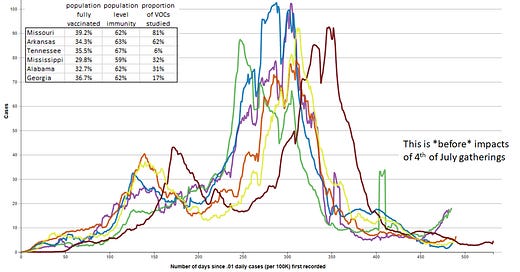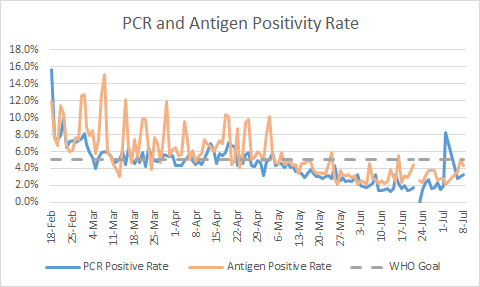The COVID Digest, 08Jul2021
Increases across multiple metrics point to a possible new surge for the South
Hey there readers, we need to talk about some increases that are happening now in Georgia and other Southern states, the delta variant, and what to do to limit your exposure and risk.
First, let’s start with what’s happening with case rate. The graph below comes from the CDC but its setup is not what we typically see. It is showing 7-day case rate per 100,000 residents, but the x-axis is a little different. Rather than showing chronological time, it shows the length of time since the pandemic first hit a certain threshold in a given state. In any case, we’re going to look at trends. I’ve selected the states of Missouri, Arkansas, Tennessee, Mississippi, Alabama and Georgia. You’ll notice that case rates are rising rapidly for Missouri and Arkansas, and maybe that’s not a surprise because these states are in the news a lot right now for their case rates. But we are also starting to see small increases for the other states shown. Keep in mind, these increases are what we observe before the impact of 4th of July gatherings and travel can be seen. Because of the incubation period of the virus, delays in seeking a test, test turnaround time, and reporting delays, we might not see the 4th of July impact begin until late next week. But there is already significant momentum for the virus in Missouri and Arkansas. And there are some similarities between Missouri and Arkansas with Southern states that could predict real trouble if delta makes a play in Georgia.
There’s a table in the graph too that I added, using data from the CDC’s variant tracking dashboard. It updates weekly with the last update on 06Jul2021. Now, genomic surveillance is not a perfect system. They aren’t sequencing every PCR positive sample. Departments of public health often decide to send certain specimens because there was something interesting about the case. So when we talk about the proportion of specimens sequenced, just understand that it may not be a perfect representation of the reality on the ground. But delta is quickly rising to dominance in Missouri, now representing 81% of the specimens they’ve sequenced. Arkansas is the next highest of this set of states, at 62%. Mississippi and Alabama are nearly equal, at 32 and 31%, respectively. Georgia is at 17% - it was at 6% when I checked it last week. Now, because of the turnaround time on processing, sequencing and analyzing genomic sequencing, knowing that some of these specimens are chosen because they’re interesting (likely highlighted through contact tracing), this percent of specimens represents cases that were identified probably 2-3 weeks ago. All this to say that the frequency of the delta variant in these states is likely already higher than these numbers would indicate. I don’t think we need to check this frequently, but it gives us a heads up that something is coming.
So the Ozark states (Missouri and Arkansas) both have high proportions of the delta variant. But we see some similarities between these states and Southern states when we look at vaccination rates and estimated population level immunity. The vaccination rates were pulled from the HHS Community Profile Report. You can see that actually Missouri has the highest vaccination rate of all the states in this group. But vaccination is not the only path to immunity. You can also develop immunity following natural infection, although this is a riskier path. But we should be sure to factor these folks in. Georgia Tech has a tool that factors both of these populations together to estimate how much of the population is immune. As of yesterday, when I pulled these data, Tennessee has the highest population level immunity, at 67%. But the population level immunity for Missouri and Arkansas (~62%) is the same as what we observe for Alabama and Georgia (62%) and Mississippi brings up the rear with 59% of its population estimated to be immune.
So what this suggests is that Georgia and Alabama are in a similarly vulnerable position as Missouri and Arkansas. What we are seeing in Missouri and Arkansas can happen in these states as well as Mississippi. And the third column reminds us that delta’s proportion of sequenced specimens is rising.
If you are in a tan or green county in the maps shown below, you are in an area with dangerously low vaccination rates. Really, there isn’t a single county shown here that is above 50%, but the blue counties are better off. In addition, there is considerable overlap between counties with low vaccination rates and high test positivity, before delta really gets going. This makes me worry because disease is likely to spread quickly in these counties due to their low vaccination rates and we are unlikely to adequately measure how intense disease is locally because there already isn’t sufficient testing to measure disease at current levels.
If we drill down in to Georgia over recent weeks, we can see that the increases are impacting all county types, but especially rural counties. A lot of the counties shown above with high test positivity rates are rural counties.
But case rate isn’t the only thing rising. The proportion of patients in the hospital in Georgia due to COVID-19 (called the COVID-19 patient census) is also rising both for the state overall and for individual hospital regions including regions C, D, E, H, I, J, K, L and N. Hospital region J, which includes Savannah and the Georgia coast, is the most dramatic example. You can see how your region is impacted here.
And the thing about exponential growth that we see with surges is that things look like they’re increasing but at a manageable level for a bit. Then they rise dramatically, really fast and we are overwhelmed. That’s what is overwhelming hospitals in southwest Missouri. The South is in a really vulnerable position for something similar to happen if delta makes a play.
Test positivity in Georgia is also increasing, both for PCR and antigen testing. As this rises above 5% and beyond we will be missing cases that circulate in the community, contributing to ongoing disease spread. It’s a lot harder to control disease when you can’t see how big the problem is.
So the effort to vaccinate as many people as we can, as fast as we can, takes on an even greater sense of urgency. If you’ve gotten lucky up to this point and escaped COVID-19 infection perhaps this has caused you to think you don’t need a vaccine. But make no mistake, the delta variant is more likely to find you than its predecessors. If you’ve been waiting for whatever reason, it’s time to get vaccinated ASAP. Click here to find a dose in your area. Because I think delta is marching its way through the South. The virus has far easier freedom of movement now with few people wearing masks and people resuming pre-pandemic social interactions. And many counties in the South have such low vaccination rates that I am afraid delta will spread like wildfire.
Of course, this is a terribly concerning situation for the immunocompromised, people who can’t be vaccinated for medical reasons or parents of children under the age of 12 who currently are ineligible. Trust me, I feel it too with a kid under 12. What this means for us is that we need to double down on pandemic precautions. For our immunocompromised friends, perhaps you never let up on them in the first place. Hearing reports of fully vaccinated people who still come down with mildly symptomatic COVID-19 illness, my family (3/4 of us are fully vaccinated now) has resumed wearing masks full time when indoors with people whose vaccination status we do not know…because we need to protect our youngest kiddo. Meanwhile, we desperately hope that FDA will consider EUA for the children under the age of 12 ASAP. Remember, the vaccines are really powerful, but they are not perfect. If you live with someone who is unvaccinated or high risk, you may want to add a layer or two of additional protective measures, even if you are fully vaccinated. Prioritize outdoor activity as much as possible, though I realize this is a difficult ask during the height of summer.
Make good decisions, plan ahead and use at least 2-3 prevention strategies in combination at all times. Get vaccinated if you haven’t already and help anyone around you to do so also. If this does kick off into a surge, we will get through it as we have the others. But we should work to protect and save as many people as we can, especially since we have tools to do so.
References
https://dph.georgia.gov/covid-19-daily-status-report
https://covid-gagio.hub.arcgis.com/
https://covid19dashboardgt.shinyapps.io/us_immunitylevel/
https://nextstrain.org/groups/spheres/ncov/missouri?c=emerging_lineage&m=div&r=location
https://covid.cdc.gov/covid-data-tracker/#compare-trends_newcasesper100k
Georgia COVID-19 Updates is a free newsletter that depends on reader support. If you wish to subscribe please click the link below. There are free and paid options available.
My Ph.D. is in Medical Microbiology and Immunology and I am Chair of the Division of Natural Sciences and Mathematics at the University of Saint Mary. I've worked at places like Creighton University, the Centers for Disease Control & Prevention and Mercer University School of Medicine. All thoughts are my professional opinion, do not represent the views or opinions of my employer and should not be considered medical advice.











Is there data tracking immunity against the new variants(especially delta) for young adults who have had Covid and have the antigens? Trying to convince my 19 yo son that the risks of getting the vaccine(rare cardio issues) do not outweigh risks of not being immune. Thanks.